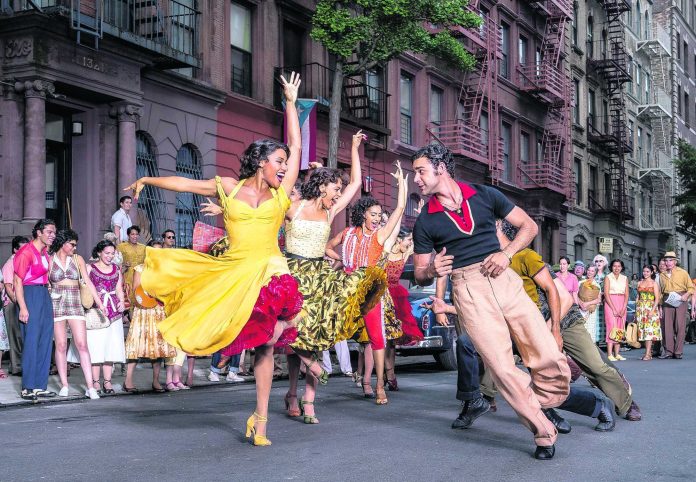
By JAKE COYLE
AP Film Writer
We’re so rife with reboots and remakes today that it can take a moment to gauge just what Steven Spielberg’s “West Side Story” is. It isn’t a papered-over modernizing or a thinly disguised retread. It’s a feat of reconstruction. Spielberg, Tony Kushner and Steven Sondheim have taken the original play and reworked it from the inside, burrowing into the DNA of “West Side Story” and its characters to recast, reconsider, deepen and clarify one of the 20th century’s most iconic musicals.
It is, I think, a better movie than the 1961 original, by Robert Wise and Jerome Robbins, in almost every respect. The Sharks, the Puerto Rican gang who squares off with the white Jets in 1950s New York, have been a given a new and fuller life, bringing “West Side Story” into balance and righting some of the wrongs of the original in its stereotyped depictions. Rachel Zegler’s María, Ariana DeBose’s Anita and David Alvarez’s Bernardo are, to remarkable degree, what makes this “West Side Story” sing. And the story, as scripted by Kushsner, is more emotional and complex than ever, fully realizing the “Romeo and Juliet” tragedy while shading the ’50s gang strife with notes of today’s divisions and battles of gentrification.
And, yet, as fully realized and impeccably crafted as this “West Side Story” is, I’m not sure it matches the power and force of the original. As problem-filled as that movie was 60 years ago, with Natalie Wood as the Latina Maria, its potency is impossible to shrug off. There was Robbins’ electric choreography, the expressionist Panavision color and Rita Moreno — my god, Rita Moreno — a dynamo of almost overwhelming talent. The 1961 “West Side Story” was propelled by a teeming, lurching mid-century America energy — a surge of bodies in motion, syncopated with finger snaps. This “West Side Story” comes out of a different cultural moment, one of tasteful renovation — three 20th century titans of the arts, like master remodeling craftsmen, shifting and rearranging the play’s latticework of scaffolding, brick and fire escape.
Delayed a year by the pandemic, “West Side Story” (Dec. 10 in theaters) arrives with a glow of eulogy, coming on the heels of Sondheim’s death at 91. “West Side Story,” originally staged in 1957, was Sondheim’s first musical. (Robbins conceived it, with music by Leonard Bernstein, book by Arthur Laurents and lyrics by Sondheim.) Six decades later, it’s Spielberg’s first musical, too. Spielberg, naturally, doesn’t finally wade into song and dance with some little one-act but with possibly the most beloved musical there is. (He does, after all, know a thing or two about sharks.) When it comes to big-screen grandeur, there’s still nobody who does it better.
What’s immediately apparent is that Spielberg, with his regular cinematographer Janusz Kaminski, has elected for a paler, desaturated palette and a slightly grittier, more grounded sense of place. The opening shot skims over a giant pile of rubble — “slum clearance” to make way for the Upper West Side’s Lincoln Center. (That bit drew chuckles at the screening I attended, at Lincoln Square’s Walter Reade Theatre.) With the wrecking ball coming for San Juan Hill and a new, wealthier New York to build, the days are numbered for both the Sharks and the Jets. Their turf war is misguided from the start; they’re both about to have no turf, at all. Corey Stoll’s Lieutenant Schrank (superior of Brian d’Arcy James’ Officer Krumpke) spells it out for them: A remade neighborhood is coming that won’t have room for Puerto Ricans like the Sharks or “the last of the can’t-make-it Caucasians.”
It’s narrative, context and authenticity that give Spielberg’s “West Side Story” its own verve. It most definitely still plays the hits, but the film feels less like a Broadway-to-screen transfer than a cinematic staging of a classic. The set pieces are often extraordinary. “In America” moves from the sound stage to the street in an on-air showstopper. “One Hand, One Heart,” in which Tony (Ansel Elgort) and Maria speak their private wedding vows, has been uprooted to the Cloisters, where it shines with a holy tenderness. Some classics — “I Feel Pretty,” performed inside Gimbels department store (where Maria works as a cleaner) — may be too familiar to sound new again. But songs like “Cool” are thrillingly alive, in part because Spielberg’s nimble camera is in on the dance, an eager partner to Justin Peck’s choreography.
But as much as these are set pieces — and as beautiful as Zegler’s voice is — what makes them work so well is that they aren’t isolated, but come out of the more fully formed interiors of the characters. Tony is just out of prison and staying in the drugstore basement of a new character, Valentina (Moreno, connecting movie past and present). His best friend, Jets leader Riff (Mike Faist, terrific), is itching for a fight with the Sharks, and Faist plays him with a hint of mean, knowing despondency. Looking down on Puerto Ricans, he seems to realize, is all he has.
The Sharks, meanwhile, are led by Alvarez’s Bernardo: boyfriend to Anita and older brother to Maria. There is more talking in this “West Side Story,” and that includes Spanish without subtitles that intermingles with English. It’s one of many details that endeavor to add authenticity to a drama with new layers of meaning. Not only are Bernardo, Anita and Maria wrestling with their standing in America, they are seizing a place in this deeply American musical. (Each actor does so, beautifully.) The blade-gleaming ethnic war at the heart of “West Side Story” is here less of a ready substitute for the Montagues and Capulets than a metaphorical battleground for today’s discord, with plenty of pain and injustice to go around, and maybe some measure of hope.
That backdrop casts the romance between Maria and Tony in starker relief, and two actors — the sensational breakout Zegler and a never-better Elgort — have a warm chemistry. From the first time they see each other through the swirl of a school dance, their eyes are locked on one another. A lot of Elgort’s performance, with a touch of Marlon Brando’s melancholy sweetness, is in simply looking at Maria. Their rapport reaches a crescendo in the duet of “Tonight.”
But that moment feels obscured by more than the fire-escape ironwork that cages it. It’s possible that there are issues to the musical that can’t be overcome. Is it better to let a once-one-sided view of race in America recede into the past? It remains, for instance, ridiculous how Maria shrugs off the death of her brother in the final act. It’s a disservice to her character that squanders some the magic that’s accrued.
Yet this “West Side Story” succeeds most as a revival not just of Robbins’ musical but of the best of classical, studio-made, big-screen cinema. It goes without saying that that’s an imperiled species today — because of the pandemic, yes, but also because of other deeper currents in the movie industry. (The studio this was set up with was swallowed just before filming began.) “West Side Story” in that way feels as much like a revival as it does a swan song for a grand style of moviemaking that will hopefully persist, as Maria sings, “somehow, someday, somewhere.”



















